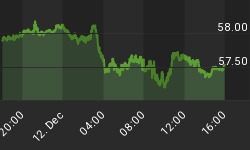The recent, aggressive ECB ease, combined with some mild Fed growls about increasing rates "at some point," ought to be good news for the dollar against the Euro. And so it has been, although as you see in this weekly chart (source: Bloomberg) the weakening of the Euro has been (a) mild and (b) started more than a month before the ECB actually took action. (Note that the units here are dollars per Euro).

Even though the ECB did considerably more than expected, much of that was in the form of a promise; until the body takes concrete steps towards implementing some of the new QE forms, the decline in the Euro is likely to be relatively slow and steady. Similarly, although the Yen has stopped weakening in 2014, I expect that trend has further to go as long as the Bank of Japan doesn't lose its nerve with easing. In any event, both of those central banks seem at the moment to be more dovish than the Fed, which augurs for dollar strength.
Is that bad for commodities? The conventional wisdom is that since many commodities trade in dollars, a strong dollar implies weak commodities and vice versa.
There is some support for this view. The chart below (source: Bloomberg) shows weekly levels of the dollar index versus the DJ-UBS index, going back to 1996 or so. The correlation is okay, at -0.725.

Note, though, that this is a correlation of levels. If you look at a correlation of changes, which is what you would need to use dollar movements as a trading model for commodities, it is effectively zero. (These two series aren't lovers, moving together always, but just friends coming together to the same place from time to time). Moreover, the regression of levels says that commodities are currently 15% or so cheap - the red smudge on the chart shows the current levels (yet another way that commodities appear to be cheap). Finally, the beta is quite low: if the dollar index rose 20%, it would correlate with roughly a 20% decline in commodities...if commodities preserved the same level of cheapness. To be sure, that is a sizeable drop but a 20% rise in the dollar would put it at levels not seen in more than a decade.
In any event, be careful not to confuse the nominal dollar price of commodities with the real price (I've made this argument from time to time in many contexts - see for example here, here, and here). Although changing the value of the dollar will diminish the price of commodities in dollars relative to what they would otherwise would be, if the global price level rises then the price of commodities will rise with it - they just may rise less than they otherwise would. And, since commodities typically experience their highest inflation "beta" at the beginning of an increase in inflation, it is reasonable to expect that commodities' rise will be enough to cause any dollar-inspired softness to be completely obscured.
You still want to be long commodities if we are in an inflationary upswing, regardless of what the Fed does. And, needless to say, I am somewhat skeptical that the Fed will do anything particularly aggressive on the tightening side!
You can follow me @inflation_guy!
Enduring Investments is a registered investment adviser that specializes in solving inflation-related problems. Fill out the contact form at http://www.EnduringInvestments.com/contact and we will send you our latest Quarterly Inflation Outlook. And if you make sure to put your physical mailing address in the "comment" section of the contact form, we will also send you a copy of Michael Ashton's book "Maestro, My Ass!"
















